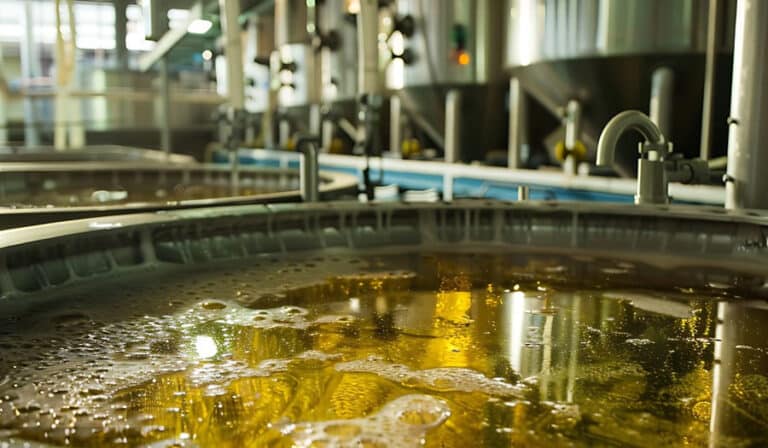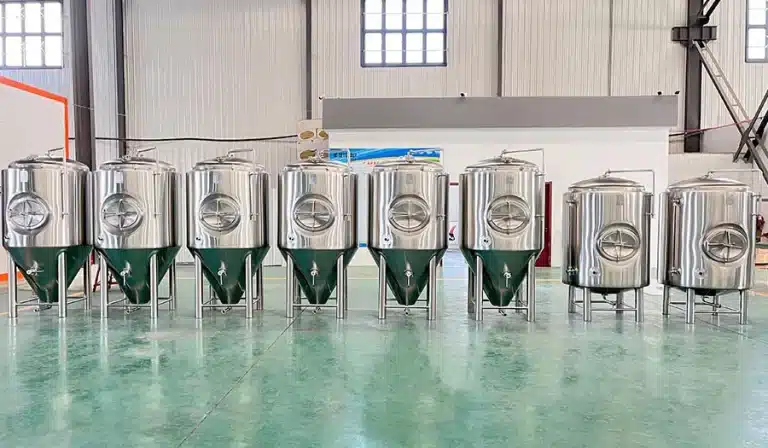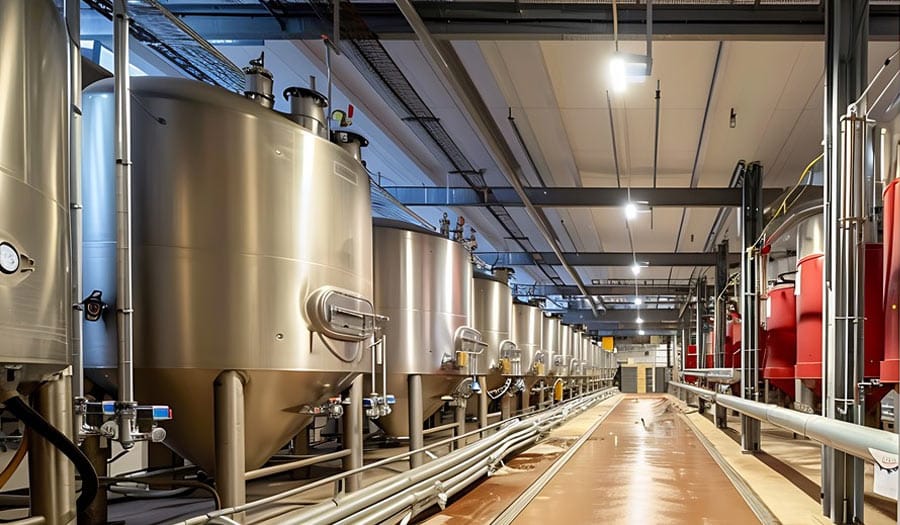Depósitos de fermentación de acero inoxidable are important equipment in modern industrial production. With the rapid development of craft beer, wine, brewing industry, and other food and beverage industries, stainless steel fermentation tanks are becoming increasingly important. To ensure the efficiency of the fermentation process, control the stability of the fermentation environment, and improve product quality, more and more breweries, fermentation plants and food production companies choose stainless steel fermentation tanks.
Overview of stainless steel fermentation tanks
Stainless steel fermentation tanks are a type of equipment specifically used in the fermentation process, usually made of high-quality stainless steel materials. The corrosion resistance, high temperature resistance, and structural stability of this material enable stainless steel fermentation tanks to withstand the high temperature, pressure, and material corrosion generated during the fermentation process.
Principales componentes de los depósitos de fermentación de acero inoxidable:
- Tank body: The main part of the fermentation tank, usually made of 304 or 316 stainless steel, with good corrosion resistance and oxidation resistance.
- Tank cover: Used to close the top of the fermentation tank, usually designed with a gas discharge port (such as a vent valve) to ensure that the gas generated during the fermentation process can be effectively released.
- Stirring system: Some stainless steel fermentation tanks are equipped with a stirring system to ensure the uniformity of the fermentation liquid and promote the distribution of nutrients during the fermentation process.
- Temperature control system: To maintain the ideal temperature conditions during the fermentation process, stainless steel fermentation tanks are usually equipped with temperature control equipment, such as external heating pipes, cooling jackets, etc.
- Pressure gauges and thermometers: Monitor the temperature and pressure inside the fermentation tank to ensure the stability of the fermentation process.
- Discharge pipes and drain ports: Used to discharge by-products such as gas and liquid generated during the fermentation process to prevent backlogs from affecting the material fermentation process.

Usos de los depósitos de fermentación de acero inoxidable
Fabricación de cerveza
In the process of beer brewing, the fermentation of yeast is a key step in producing alcohol and fermentation. Traditional beer brewing mostly uses wooden or glass containers, but with the advancement of technology and strict requirements for product quality, more and more breweries have begun to use stainless steel fermentation tanks. Its excellent corrosion resistance and antioxidant properties ensure the stability of the fermentation process, avoid the infiltration of harmful substances, and ensure the residue and taste of beer. Stainless steel modern fermentation tanks also play a role in temperature control. The system, automatic stirring system, and advanced monitoring equipment further improve the brewing efficiency and product consistency.
Wine fermentation
The fermentation process of wine is similar to that of beer brewing and also needs to be carried out in a fermentation tank. In wine fermentation, choosing a stainless steel tanque de fermentación can not only avoid the influence of the taste of wood or other materials but also provide a closed and controllable fermentation environment. The fermentation tank can maintain the temperature well and effectively avoid the interference of temperature fluctuations in the fermentation process. In addition, the gas explosion generated during the fermentation of wine needs to be discharged in time. Modern fermentation tanks are generally equipped with gas discharge devices to ensure the smooth progress of the fermentation process.
Dairy fermentation
The production of dairy products such as yogurt, cheese, etc. also follows the fermentation process. Similar to beer and fermented wine, dairy fermentation needs to be carried out under strictly controlled temperature and humidity conditions. Stainless steel fermentation tanks play a crucial role in this process. Its good thermal excitation performance can ensure that the temperature of the fermentation environment remains stable and avoid fermentation failure due to temperature fluctuations. At the same time, the surface of stainless steel materials is smooth and not easy to breed bacteria, which meets the hygiene standards of food production.
Pharmaceutical and chemical industries
In the pharmaceutical and chemical industries, stainless steel fermentation technology is required in many production processes to produce biological products such as antibiotics, vaccines, and enzymes. In order to ensure the quality of the products and the stability of the production process, companies usually use stainless steel fermentation tanks for large-scale fermentation processes in the pharmaceutical and chemical fields. There are very high requirements for the cleanliness, corrosion resistance, and high-pressure resistance of the equipment, and stainless steel accessories meet these requirements.
Ventajas de los depósitos de fermentación de acero inoxidable
- Strong corrosion resistance: Stainless steel has strong corrosion resistance and can resist the appearance of substances such as acid, alkali, and salt. During the fermentation process, especially in the process of beer brewing and wine fermentation, the acid environment of raw materials and fermentation liquid causes corrosion to the equipment, and stainless steel materials can effectively avoid this problem and extend the service life of the equipment.
- High-temperature resistance and stability: Stainless steel can work stably in a high temperature environment and will not be deformed or damaged due to temperature fluctuations. A lot of heat is usually generated during the fermentation process. If the fermentation tank cannot effectively withstand this heat, it may affect the fermentation effect. Stainless steel materials can not only withstand high temperatures but also have good thermal fermentation performance, which is conducive to temperature control during the fermentation process.
- Easy to clean: The surface of stainless steel is smooth, not easy to accumulate, bacteria, and it is very easy to clean. In many industries, hygiene standards require that equipment must be cleaned and disinfected regularly. Stainless steel fermentation tanks can be thoroughly cleaned by high-temperature steam, chemical cleaners, etc., so as to ensure the quality of the fermentation liquid and the safety of the product.
- Good sealing: Stainless steel fermentation tanks are usually designed to be very sealed, which can effectively prevent bladders from entering the fermentation liquid. Good sealing can not only improve the efficiency of fermentation but also avoid unnecessary gas loss and ensure the smooth progress of the fermentation process.
- High-pressure resistance and high control: In some special fermentation processes, it is necessary to maintain a higher pressure. For example, in fermentation reactions with increased gas production, stainless steel tanks can withstand higher pressures to avoid safety hazards such as accidents.
- Wide adaptability: Stainless steel fermentation tanks are not only used in beer brewing and wine fermentation but also dairy fermentation and pharmaceutical chemical industries. Its high temperature resistance, corrosion resistance, and easy cleaning characteristics can operate stably in various environments.
Maintenance of stainless steel fermentation tanks
Daily maintenance
Daily inspection is the basis. Before use, the tank body, valve, temperature control system, stirring device, and gas exhaust system must be carefully checked to ensure that the equipment has no obvious damage, leakage, or abnormality. Regularly check the defects and welding parts of the tank body to prevent equipment failure due to wear or corrosion. Especially for fermentation tanks used in high-temperature or high-pressure environments, the sealing and pressure control systems must be paid special attention.
Regular inspection and adjustment
Regular maintenance is essential for the long-term operation of the equipment. The sensors, pressure gauges, temperature control devices, etc. of the fermentation tanks need to be adjusted and inspected regularly to ensure their accuracy and reliability. In addition, the lubrication system also needs to be maintained regularly to reduce the wear of mechanical parts and increase the service life of the equipment. Especially for the stirring system, the working status of the motor and transmission device must be checked to ensure uniform stirring.
Limpieza y desinfección
Cleaning and disinfection is another important maintenance link, especially in the food and beverage industry, where strict hygiene requirements determine the importance of cleaning and disinfection. After each fermentation, the inside of the tank body needs to be thoroughly cleaned to avoid residual fermentation substances, which can prevent fatal and bacterial contamination during the cleaning process. Suitable stainless steel should be used during cleaning to avoid scratching the tank body with hard objects and ensure that the tank body is wiped without residue. In addition, disinfection cannot be ignored. High-temperature steam disinfection effectively kills microorganisms and ensures the disinfection of the tank. The sanitation of the equipment.
Solución de problemas
Troubleshooting and emergency treatment are also part of maintenance. When the equipment fails, it is necessary to stop the operation immediately, check the components with problems, and repair them in time. Recording the detailed information of each failure will help provide data support for future maintenance and reduce the probability of similar problems in the future.

PREGUNTAS FRECUENTES
In which industries are stainless steel fermentation tanks mainly used?
- Food industry: such as beer brewing, wine fermentation, production of soy sauce and vinegar, fermentation of dairy products (such as yogurt and cheese), etc.
- Beverage industry: such as the production of carbonated drinks, fruit juices, fermented teas (such as kombucha), etc.
- Biomedical industry: used to produce vaccines, antibiotics, enzyme preparations, and other biological products.
- Chemical industry: used for the synthesis of some chemical substances that require the participation of microorganisms (such as organic acids, amino acids, etc.).
What is the typical capacity of a stainless steel fermentation tank?
The capacity of the stainless steel fermentation tank can be customized according to production needs. Common capacities range from tens of liters to thousands of liters. In large-scale industrial production, 1000L, 5000L, or even larger fermenters are usually used, while in laboratories and small-scale production, the capacity is usually 10L to 500L.
How long can a stainless steel fermentation tank be used?
The service life of a stainless steel fermentation tank is usually between 10 and 20 years, and the specific lifespan is affected by material quality, frequency of use, and maintenance. Regular maintenance and timely repairs can significantly extend its service life.
What is the maintenance cycle of stainless steel fermentation tanks?
The maintenance cycle of stainless steel fermenters usually depends on the frequency of use of the equipment, the working environment, and production requirements. Generally speaking, daily inspections should be performed before each use; regular maintenance, such as pressure testing, sensor calibration, lubrication system inspection, etc., should be performed every quarter or half a year.




